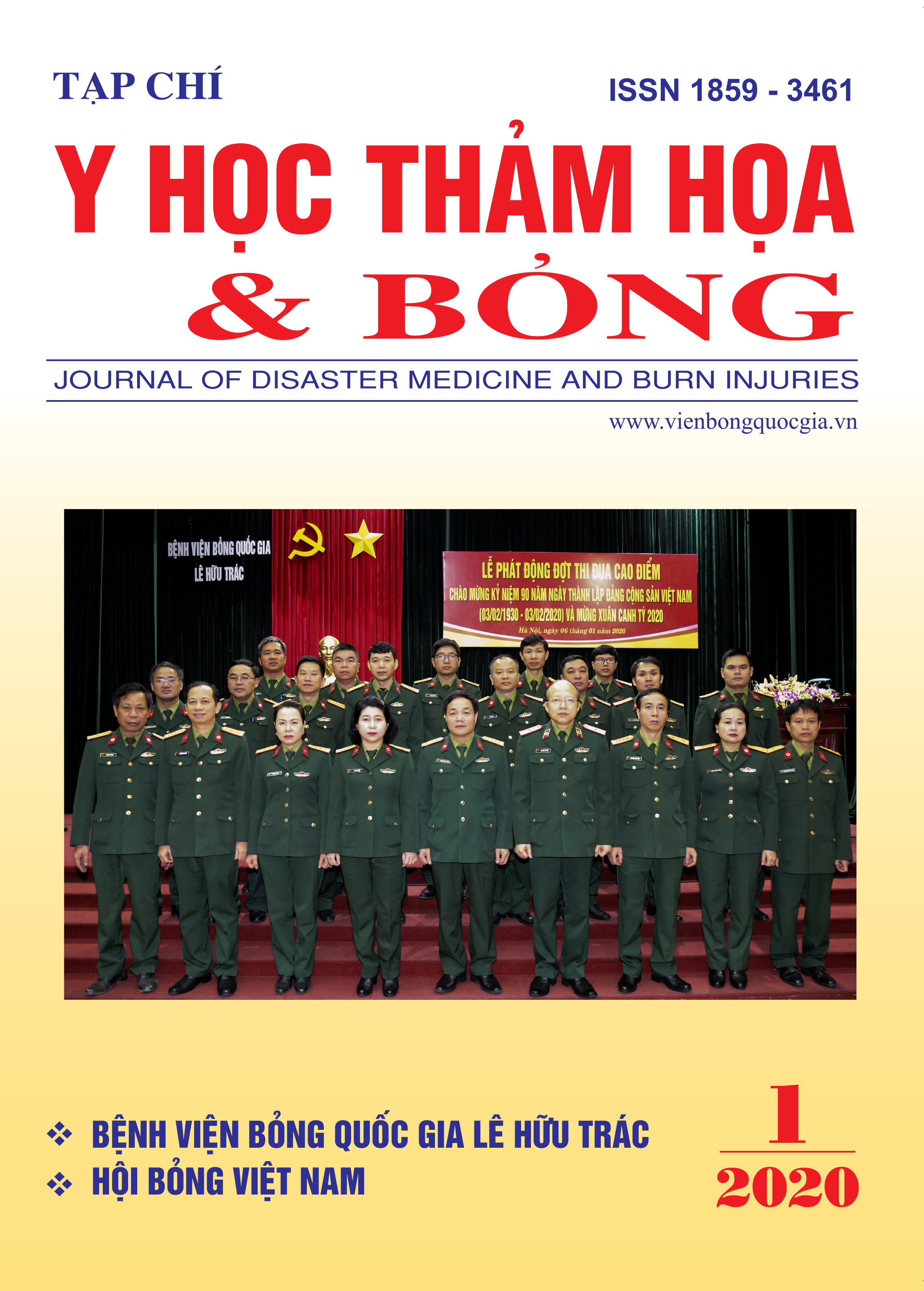Changes of resting energy expenditure (REE) and effects of propranolol post severe burns
Main Article Content
Abstract
Objective: To investigate changes of resting energy expenditure (REE) and effects of propranolol post severe burns.
Patients and methods: One hundred twenty-four severely burned adult patients treated at the National Burns Hospital from June 2016 to August 2018. The study patients were randomly divided into two groups, the propranolol group included 62 patients and the control group (no use propranolol) included 62 patients. REE of burn patients were measured at the time of admission (T1), 2nd (T2), 3rd (T3), 4th (T4) and week 5 (T5) post-burn. Results were analyzed, compared, determine the relationship with area, depth of burns, sex and treatment outcomes for conclusion.
Results: At the time of admission, REE was 2431.87 Kcal/day, then increased at the time T2 and T3, REE decreased gradually from the time T4 and reached 2618.03 Kcal/day at the time T5. REE of burn patients at all times increased by about 200% compared to REE of healthy individuals have the same age, gender, height and weight. REE of group of patients died was higher than group of patients remaining (pT2 < 0.05, pT3 < 0.05), male patients was higher than female patients (pT1 < 0.01, pT2 < 0.01, pT4 < 0.05). REE at T2 and T3 of group of patients with burn area ≥ 60% total body surface area (TBSA) was higher than group of patients with burn area from 40% to 59% TBSA and group of patients with burn area ≤ 39% TBSA. REE of group of patients with deep burn area ≥ 20% TBSA was higher than group of patients with deep burn area <20% TBSA (pT3 < 0.01). REE at the time T2 and T3 of group of patients using propranolol was lower than group of patients who did not use propranolol with (p < 0.05).
Conclusion: Variable values of REE in patients with severe burns at different time post-burn. REE of burn patients increased from 163% to 207% compared to the predicted value, the highest in the period from week 2 to week 3 after burns. REE of group of patients died was higher than group of patients remaining, male patients was higher than female patients. Patients with large burn area, the REE was high. Propranolol did recrease REE of patients with severe burns compared with the control group. However, REE of burn patients using propranolol was higher than normal healthy people.
Article Details
Keywords
Resting Energy Expenditure, Burn injury, Propranolol
References
2. Herndon D.N. and Tompkins, R.G. (2004) Support of the metabolic response to burn injury. The Lancet 363, 1895-1902.
3. Hart D., et al. (2000) Persistence of muscle catabolism after severe burn. Surgery 128, 312-319.
4. Gauglitz G.G., et al. (2011) Burns: Where are we standing with propranolol, oxandrolone, rhGH, and the new incretin analogues? Current opinion in clinical nutrition and metabolic care 14, 176.
5. Herndon D.N., et al. (2012) Long-term propranolol use in severely burned pediatric patients: a randomized controlled study. Annals of surgery 256, 402.
6. Auger C., et al. (2017) The biochemical alterations underlying post-burn hypermetabolism. Biochimica et Biophysica Acta (BBA)-Molecular Basis of Disease 1863, 2633-2644.
7. Jeschke M.G., et al. (2008) The pathophysiologic response to severe burn injury. Annals of surgery 248, 387.
8. Clark A., et al. (2017) Nutrition and metabolism in burn patients. Burns & trauma 5, 11.
9. Breitenstein E., et al. (1990) Effects of beta-blockade on energy metabolism following burns. Burns 16, 259-264.
10. Hart D.W., et al. (2002) β-Blockade and growth hormone after-burn. Annals of surgery 236, 450.
11. Jeschke M.G., et al. (2008) Combination of recombinant human growth hormone and propranolol decreases hypermetabolism and inflammation in severely burned children. Pediatric Critical Care Medicine 9, 209-216.


